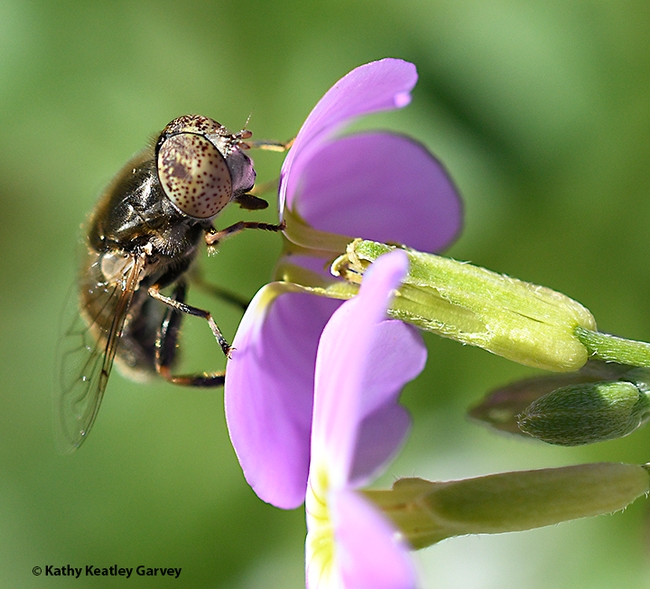Ever seen a lagoon fly?
It's a syrphid fly, Eristalinus aeneus, distinguished by small black spots patterning its eyes. Syrphids, also known hoverflies or flower flies, hover over a flower before foraging. They're pollinators.
Native to Europe and widespread throughout Europe and the United States, it draws its common name from its habitat of lagoons, ponds, slow-moving rivers, streams and irrigation ditches.
This little pollinator (below) took a liking to our Virginia stock (Malcolmia maritima). It competed with a few honey bees, but kept low.
The lagoon fly is a common research subject. Recently a team of international researchers (University of Wisconsin, Sweden, Australia and India) published their work, "Innate Floral Object Identification in the Generalist Solitary Hoverfly Pollinator Eristalinus aeneus," in BioRxiv, the preprint server for biology.
The abstract:
"All animals must locate and identify food for their survival. Most insects are solitary. Newly emerged solitary insects must therefore employ innate identification of food cues to locate relevant nutritive objects from a distance. Innate preferences for food cues should be both specific enough to allow discrimination between food and non-food objects and general enough to allow for the variety of food objects relevant to each species' ecology. How insects with small nervous systems are able to encode these cues innately is an area of intense study for ecologists and neuroscientists alike. Here, we used the solitary generalist pollinator Eristalinus aeneus to understand how the innate search template used to identify multiple floral species can arise through a small number of sensory cues spanning multiple modalities. We found that innate floral choices of the hoverfly E. aeneus are a product of contextual integration of broad, plant-based olfactory cues and visual cues, where a combination of radial symmetry and reflection in the 500-700 nm wavelength range was particularly important. Our study, therefore, shows how tiny brains can efficiently encode multimodal cues to identify multiple relevant objects without prior experience."
The research originates from The NICE Lab, which stands for Naturalist-Inspired Chemical Ecology (corresponding authors: Aditi Mishra, at aditi@nicelab.science, and Shannon Olson at shannon@nicelab.science).
You got to love the NICE website: "We are creative, dedicated, and adventurous. We are NICE." And when they recruit they ask "Are you NICE?"
Attached Images:
